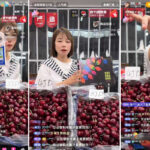Chile's Copefrut launches commercial platform in China amid rapid market evolution

 Copefrut, one of Chile's leading fruit exporters, on Friday launched a new commercial platform in China to give itself greater control of its produce along the supply chain and position itself for further growth in the rapidly evolving market.
Copefrut, one of Chile's leading fruit exporters, on Friday launched a new commercial platform in China to give itself greater control of its produce along the supply chain and position itself for further growth in the rapidly evolving market.
The company has employed a team of experts who will receive and inspect the imported fruit at sites with cold storage facilities in Guangzhou and Shanghai before passing it onto the client.
Speaking to Fresh Fruit Portal, Copefrut's general manager Andrés Fuenzalida said doing so will allow the company to verify that the fruit's arrival quality meets the high standards required by the Chinese market.
He added that it contrasts to the traditional approach taken by exporters, who usually have no way of reviewing the fruit's quality and condition themselves in the destination.
The commercial platform will also help Copepfrut to strengthen its relationships with retailers, staying ahead of the curve as the Chinese market evolves and the retail channel becomes increasingly important.
Fuenzalida explained the decision to create the commercial platform came about following strategic planning carried out by the company's management in 2018.
"One of the pillars of that strategy is to reverse a little bit the way we saw our business, which was how exporters traditionally view it - 'I receive the fruit and I decide which market I can send it to'," he said.
"Thinking about how the world is nowadays, we said 'no, the most important thing is to be in the market and to develop products for our consumers'. And therefore our focus of attention must be the consumer, and from there we must work backward to our facilities and also to our farms to produce what the consumer wants."
Copefrut began in Chile in the 1940s as a farmer cooperative, growing over the decades in tandem with the evolution of the Chilean fruit industry. The company was one of the first in the industry to export fruit to the Asian country and its brand name is now well established.
As well as being a major exporter of fruits including plums, blueberries, apples and kiwifruit, Copefrut is Chile's second-largest cherry shipper, typically representing around 10% of the country's total export volumes, of which around 85% goes to China annually.
Fuenzalida said that Copefrut had therefore seen a "tremendous opportunity" for this new approach in China, a market where high fruit quality is rewarded with higher prices than most other markets.
"We want to be closer and to be responsible for the fruit at the point of delivery in China. We don't want to send the fruit from here on a ship and later lose our control over the fruit," he said.
 "That is why we have created a commercial platform in China, where around seven or eight people will work, whose objective is to maintain the control and protect the quality of the product."
"That is why we have created a commercial platform in China, where around seven or eight people will work, whose objective is to maintain the control and protect the quality of the product."
He added that the platform will help Copefrut stop any potential problem earlier, have a more consistent quality and improve the service to its customers.
The new team is made up of Chinese experts in fruit quality control and uses the same tools as those in Chile for greater consistency. It is split between Guangzhou and Shanghai and will be responsible for the entire process from ensuring the documentation is in order for the incoming fruit, taking it to the cold storage facilities for revision, and either delivering it to the customer or letting them know that it is ready to be collected
Part of the Chilean staff will also be in the market during the season to provide support and to be able to give feedback to the growers.
To begin with, the platform is mainly being used for cherries, but the longer-term plan is to use it year-round for all the fruits it sells in China. Copefrut will use it to strengthen connections to the main retail channels in China, which include supermarkets, specialized fruit stores, and e-commerce companies.
He also emphasized the need to develop new products specifically suited to these channels, such as different sizes and types of packaging.
"We are trying to boost our relationships with regional retail chains, and what we did in the strategy is to try to give our label to a store or chain in each region or group of regions and give them the representation for our label," he said.
He added that this kind of alliance would not only help to safeguard the fruit's quality, but it would also allow Copefruit to better understand the rapidly evolving needs of the Chinese consumer.
Expectations for this cherry season and beyond
Overall, Fuenzalida had high expectations for the current Chilean cherry season, which is now into its peak weeks for harvesting. He said that while industry-wide volume estimates were still unclear, it seems as though production would end up around 20% lower than last season's record of 184,000 metric tons (MT).
"I think that last year, in spite of the large quality of fruit we still had good quality, and this year we also seeing good fruit, especially for the later varieties," he said, explaining that those varieties, in particular, were of excellent size and color this year.
"So I think that it's going to be a very good season and that our Chinese consumers are going to be very happy because there will be good fruit and we have worked very hard to supply a consistent product."
Looking toward the future, Fuenzalida said that while Chinese consumers' love of cherries meant that the market could absorb huge volumes of fruit, it was risky to have such a high dependence on one single market.
"That is why we are also working to develop programs with supermarkets in the U.S., in Brazil, and in Europe, looking for the fruit that they want and that can fetch a good price," he said.
"We don't want to cause any harm to our growers, but we believe that to be responsible, while China is the focus, we have to develop other markets. Nowadays we have good programs with supermarkets in Brazil and we also have programs in the U.S. that have been very successful."
Asked whether he expected Chile would eventually ship a lower proportion of cherries to China, he said that would all depend on how global markets evolve.
"Currently it is very difficult to leave China, because they pay better prices than other markets, except for certain sizes and colors," he said, but he believed that with time the percentage shipped to other markets would increase.
"China is the main market and I believe that it is going to be the main consumer for a long time. But with the quantity of cherries that Chile is going to produce, and with the number of orchards that there will be, we are surely going to have to go to other markets."














































